The Apple iPhone 11, 11 Pro & 11 Pro Max Review: Performance, Battery, & Camera Elevated
by Andrei Frumusanu on October 16, 2019 8:30 AM ESTSystem & ML Performance
Having investigated the new A13’s CPU performance, it’s time to look at how it performs in some system-level tests. Unfortunately there’s still a frustrating lack of proper system tests for iOS, particularly when it comes to tests like PCMark that would more accurately represent application use-cases. In lieu of that, we have to fall back to browser-based benchmarks. Browser performance is still an important aspect of device performance, as it remains one of the main workloads that put large amounts of stress on the CPU while exhibiting performance characteristics such as performance latency (essentially, responsiveness).
As always, the following benchmarks aren’t just a representation of the hardware capabilities, but also the software optimizations of a phone. iOS13 has again increased browser-based benchmarks performance by roughly 10% in our testing. We’ve gone ahead and updated the performance figures of previous generation iPhones with new scores on iOS13 to have proper Apple-to-Apple comparisons for the new iPhone 11’s.

In Speedometer 2.0 we see the new A13 based phones exhibit a 19-20% performance increase compared to the previous generation iPhone XS and the A12. The increase is in-line with Apple’s performance claims. The increase this year is a bit smaller than what we saw last year with the A12, as it seems the main boost to the scores last year was the upgrade to a 128KB L1I cache.

JetStream 2 is a newer browser benchmark that was released earlier this year. The test is longer and possibly more complex than Speedometer 2.0 – although we still have to do proper profiling of the workload. The A13’s increases here are about 13%. Apple’s chipsets, CPUs, and custom Javascript engine continue to dominate the mobile benchmarks, posting double the performance we see from the next-best competition.

Finally WebXPRT represents more of a “scaling” workload that isn’t as steady-state as the previous benchmarks. Still, even here the new iPhones showcase a 18-19% performance increase.
Last year Apple made big changes to the kernel scheduler in iOS12, and vastly shortened the ramp-up time of the CPU DVFS algorithm, decreasing the time the system takes to transition from lower idle frequencies and small cores idle to full performance of the large cores. This resulted in significantly improved device responsiveness across a wide range of past iPhone generations.
Compared to the A12, the A13 doesn’t change all that much in terms of the time it takes to reach the maximum clock-speed of the large Lightning cores, with the CPU core reaching its peak in a little over 100ms.
What does change a lot is the time the workload resides on the smaller Thunder efficiency cores. On the A13 the small cores are ramping up significantly faster than on the A12. There’s also a major change in the scheduler behavior and when the workload migrates from the small cores to the large cores. On the A13 this now happens after around 30ms, while on the A12 this would take up to 54ms. Due to the small cores no longer being able to request higher memory controller performance states on their own, it likely makes sense to migrate to the large cores sooner now in the case of a more demanding workload.
The A13’s Lightning cores are start off at a base frequency of around 910MHz, which is a bit lower than the A12 and its base frequency of 1180MHz. What this means is that Apple has extended the dynamic range of the large cores in the A13 both towards higher performance as well as towards the lower, more efficient frequencies.
Machine Learning Inference Performance
Apple has also claimed to have increased the performance of their neural processor IP block in the A13. To use this unit, you have to make use of the CoreML framework. Unfortunately we don’t have a custom tool for testing this as of yet, so we have to fall back to one of the rare external applications out there which does provide a benchmark for this, and that’s Master Lu’s AIMark.
Like the web-browser workloads, iOS13 has brought performance improvements for past devices, so we’ve rerun the iPhone X and XS scores for proper comparisons to the new iPhone 11.
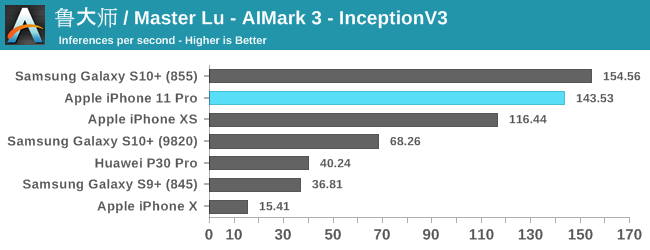
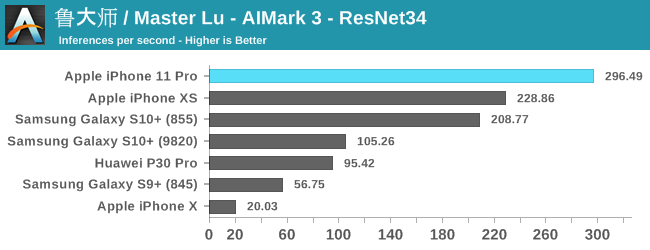
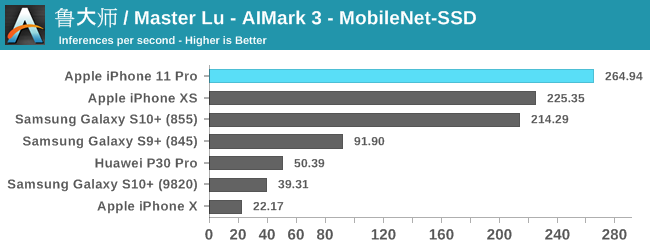
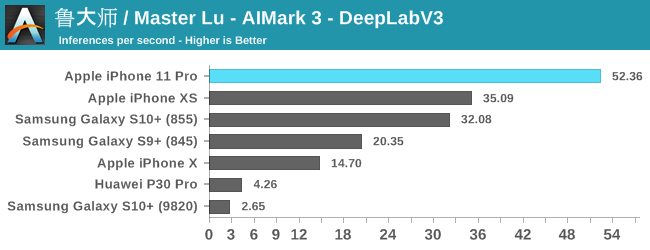
The improvements for the iPhone 11 and the new A13 vary depending on the model and workload. For the classical models such as InceptionV3 and ResNet34, we’re seeing 23-29% improvements in the inference rate. MobileNet-SSD sees are more limited 17% increase, while DeepLabV3 sees a major increase of 48%.
Generally, the issue of running machine learning benchmarks is that it’s running through an abstraction layer, in this case which is CoreML. We don’t have guarantees on how much of the model is actually being run on the NPU versus the CPU and GPU, as things can differ a lot depending on the ML drivers of the device.
Nevertheless, the A13 and iPhone 11 here are very competitive and provide good iterative performance boosts for this generation.
Performance Conclusion
Overall, performance on the iPhone 11s is excellent, as we've come to expect time and time again from Apple. With that said, however, I can’t really say that I notice too much of a difference to the iPhone XS in daily usage. So while the A13 delivers class leading performance, it's probably not going to be very compelling for users coming from last year's A12 devices; the bigger impact will be felt coming from older devices. Otherwise, with this much horsepower I feel like the user experience would benefit significantly more from an option to accelerate application and system animations, or rather even just turn them off completely, in order to really feel the proper snappiness of the hardware.


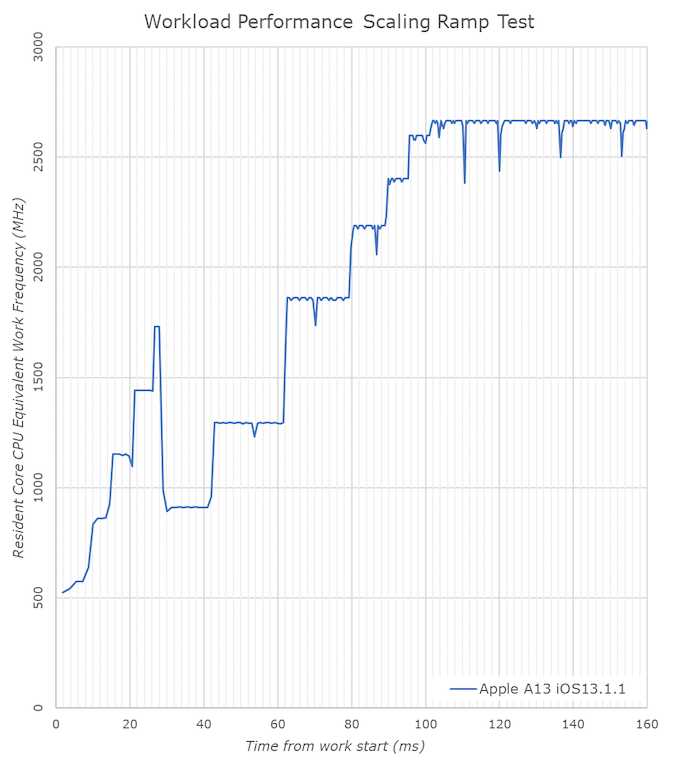








242 Comments
View All Comments
Total Meltdowner - Wednesday, October 16, 2019 - link
Bingo. I think the writer was just happy that he did notice performance improvements in this model. Still, the iPhone lacks innovation and that price tag is absurd. I'd buy it for $600 but $1000 or more? hah!Zerrohero - Wednesday, October 16, 2019 - link
“No innovation”Plenty of innovation. Read the review.
There is nothing absurd about the price tag. Not a bad price at all for your most important computer that you will use several hours per day for five years, if you want to.
Total Meltdowner - Thursday, October 17, 2019 - link
That isn't what I would call innovation. Their CPU is nice but that's about it. There is nothing you can do on the 11Pro that you couldn't do on an iPhone 7 -10.WinterCharm - Thursday, October 17, 2019 - link
Just because the visual style doesn't change does not mean there is "no innovation"There's a bunch of innovation on the chip side from Apple. You can either acknowledge that, or look like an idiot who screams no innovation while the iPhone has a 5x perf/watt lead over other ARM chips. To put that in context, it's 3-4 times the lead that Nvidia has over AMD.
Total Meltdowner - Thursday, October 17, 2019 - link
You can't do anything new with it that is worthy of praise.Jon Tseng - Wednesday, October 16, 2019 - link
Um, if you're expecting an iPhone with a removable battery, sd card slot and a non-bga socketed processor you're probably making a fairly material category error!!Zerrohero - Wednesday, October 16, 2019 - link
“ Also did author note how iPhone XS got the new battery throttling with latest iOS update ?”...which only kicks in when the battery is in bad shape and if it does, you can choose whether to throttle or not. Everybody’s XS models are running at full speed. But of course you know all this.
(Just get the battery replaced when it goes bad and you get five years of these iPhones)
A high end Android is way worse value for money because you simply can’t use it as long as an iPhone. No software updates after couple of years, apart from some rare exceptions.
When it comes to repairability, iFixit gave the new iPhones 6/10 which is better than most of the competition. For example, Samsung’s high end models are way worse when it comes to repairability.
Again, of course you know all this very well.
It’s always amusing how riled up some people get about the new iPhones. You do know that you don’t need to buy them, there are plenty of alternatives.
steven75 - Wednesday, October 16, 2019 - link
As someone living in the present year of 2019, I wish you welcome, my time-traveling friend! I hope your time spent here is illuminating before you go back to your "current" year of 2010.Total Meltdowner - Thursday, October 17, 2019 - link
There's a reason why the argument of "muh current year" is a meme. Time is irrelevant, functionality is everything.melgross - Wednesday, October 16, 2019 - link
That’s nonsense. You don’t even notice it after a while, and it’s just 2.5% of the screen. It’s a lot worse from companies that still have big bezels on top, and even one on the bottom, like the new Pixel 4 has. Totally wasted space.